What is Tefilin?
The Torah commands us four times about the Mitzva of Tefilin.
The first is in Parshas Bo:

The second is the last Posuk in Parshas Bo:

The third is in Parshas Va’eschanan:

The fourth is in Parshas Eikev:

It is the will of Hashem that the paragraphs where these four Pesukim are mentioned, should be written on parchment and donned each day. Well, not exactly - each day besides Shabbos and Yom Tov.
One may ask: “Why is this so? If this is a Mitzva of the Torah just like any other, and considering the great Kedusha of the Tefilin as discussed in depth in Seforim, wouldn’t it be appropriate to wear them on such holy days like Shabbos & Yom Tov?” The answer is that this Mitzva of Tefilin is unique - unlike any other. Tefilin is to be worn in the weekdays in order to compensate for Shabbos & Yom Tov. In other words - Tefilin is the equivalent of Shabbos & Yom Tov!
Let us explain: A person must always have two witnesses with him, establishing his Jewishness, similar to two witnesses required to establish a claim in court. The first one is Bris Milah. This is of course the universal sign of the covenant between Hashem and Avrohom Avinu that He will be the God of his children forever, and we will forever be His nation, as stated in the Torah in Parshas Lech Lecha: “Ve’hoya le’os bris beini uveineichem”. The second witness is Shabbos, which is why desecrating the Shabbos is such a severe transgression, and is on the same category in severity as Avoda Zarah - idol worship. This is because it is not merely a transgression, it is a fundamental disconnection of the special bond between Hashem and the Jewish people. This is stated in Parshas Ki Sisa: “Ach es Shabsosai tishmoru ki os hie beini uveineichem”. The terminology in the Torah for both Bris Milah and Shabbos is the Word “Os”, which literally means a “sign”, which is exactly what they are. Yom Tov is comparative to Shabbos in this regard.
Tefilin which is also called an Os, is our substitute for Shabbos. Indeed, as we find in the Gemara, it was the norm in those days to wear Tefilin the entire day. The reason why this practice is not common nowadays, is because one must always have his Tefilin in mind while wearing them, and must always make sure to have proper thoughts while wearing them. This is why we wear them mainly at the time of davening. But in essence, this is our second Shabbos from Sunday through Friday!
How is Tefilin made?
As mentioned before, the four paragraphs where Tefilin is mentioned in the Torah, must be hand written. It must also be written on parchment from a Kosher animal, by a quill (made from turkey feathers) and black ink. In essence, the exact same four Parshiyos mentioned above are written both in the Shel Yad (on arm) and Shel Rosh (on head). However, the Parshiyos Shel Yad are written on one long piece of parchment, and inserted in the Batim with one compartment, while the Shel Rosh is written on four separate pieces, and inserted in four separate compartments.
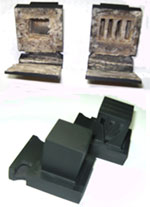 What are Batim?
What are Batim?
The literal definition of the word “Batim” is “houses”, which is exactly what they are. They are meant to house the strips of parchments which contain the words written on them. Batim must also be made from the hide of a Kosher animal. The production of both parchment and Batim are a long complicated process. Both must be processed manually by a Jewish adult male. Great care must be given while processing the hide, whether converting them into thin parchment or into thick exact-square-form Batim, so as not to tear them, and that they should be of durable quality.
Another visible distinction between the Shel Rosh and Shel Yad, is the two Shin’s on the right and left walls of the Shel Rosh, one with three heads and one with four heads. Many reasons are 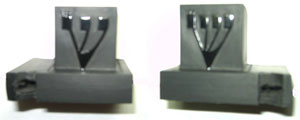 given for these Shin’s, especially according to Kabala. These Shin’s must be crafted out of the walls of the Batim itself. Great care is needed to produce Batim, and the Shin’s need extra special care to produce them properly.
given for these Shin’s, especially according to Kabala. These Shin’s must be crafted out of the walls of the Batim itself. Great care is needed to produce Batim, and the Shin’s need extra special care to produce them properly.
How are Tefilin assembled?
Each Parsha must have an empty piece of parchment wrapped around it with hair of a calf. The reason for this is to remember the Ma’ase Eigel (The golden calf) and this acts as an atonement for this sin. Some of the hair should be protruding from the Batim Shel Rosh. It is fascinating to mention the reason for these hairs which are sticking out. The Zohar Hakadosh says that the Mitzva of Tefilin is so great, that the Satan becomes extremely jealous of us, looking for sins in order to harm us. These hairs actually bribe him. When he sees that even he has a part in this great Mitzva, he calms down and leaves us alone! The Tefilin is then sewn together by Gidin which are the sinews of a Kosher Animal, and now the Batim are ready to be used, and can have the Retzuos (straps) inserted into them. Retzuos must also be made from a Kosher animal, processed manually, and great care must be given to adhere to the many laws pertaining to them, just as Parchment and Batim. To get an idea of what it takes to produce a Kosher pair of Tefilin, and for more important information, see What you should know and The necessity of inspection.
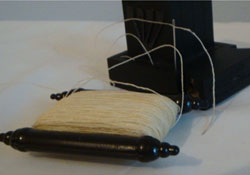
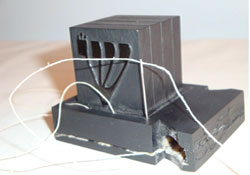
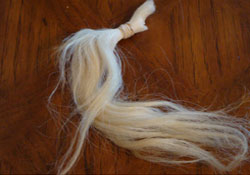
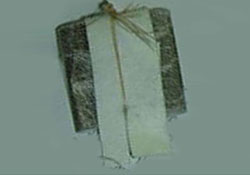
What is the difference between Rashi and Rabeinu Tam?
The four Parshiyos of Tefilin must be written in the order that they appear in the Torah. However, the order they are inserted into the Batim, is a matter of dispute between the Poskim. Rashi, as well as most Rishonim agree that they should be inserted into the Batim, in the same order they were written, meaning first Kadesh, Vehoya Ki Yeviacha, Shema, Vehoya Im Shamoa. Rabeinu Tam and other Rishonim hold that the order should be first Vehoya Im Shamoa, and then Shema. On the parchment of the Shel Yad, after Parshas Vehoya Ki Yeviacha, an empty space sufficient to write Vehoya Im Shamoa should be left blank, and then Shema should be written. Only afterwards should Vehoya Im Shamoa be written in the empty space left.
The Halacha is of course like Rashi. But many Poskim, especially the Ari Hakadosh, are of the opinion that a person should accommodate Shitas Rabeinu Tam, and have an extra pair of Tefilin. This is not merely a typical dispute where we rule according to one opinion, nullifying the other. Both are true and necessary according to Toras Hakabala.
Many ask the question: “Why did this dispute arise only about 900 years ago? What did people do from Kabalas Hatorah until then?” Many Seforim write that since Moshe Rabeinu until the days of the Rishonim, people indeed used to have two pairs of Tefilin! It is fascinating to bring from Shaalos U’tshuvos Min Hashamayim, that the Rishonim made a Shaalas Chalom, asking from Shamayim: “What is the Halacha? Is it according to Rashi, or Rabeinu Tam? The reply came: “They are both right! The same dispute existing on earth, exists in heaven! Hakadosh Boruch Hu holds like Rabeinu Tam, and the heavenly court holds like Rashi!
As mentioned above, some of the hairs which are wrapped around the Parshiyos Shel Rosh, protrude from a hole in the Batim. These hairs are wrapped around Parshas Vehoya Im Shamoa. 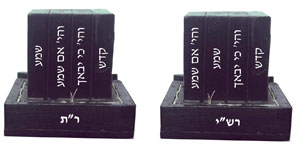 Therefore, there is a noticeable difference on the Batim Shel Rosh between Rashi and Rabeinu Tam. On Rashi, these hairs protrude from the left side of the Batim due to the fact that Vehoya Im Shamoa is positioned on the extreme left side of the Batim. On Rabeinu Tam it protrudes from the middle since Vehoya Im Shamoa is positioned in the second to the left Bayis.
Therefore, there is a noticeable difference on the Batim Shel Rosh between Rashi and Rabeinu Tam. On Rashi, these hairs protrude from the left side of the Batim due to the fact that Vehoya Im Shamoa is positioned on the extreme left side of the Batim. On Rabeinu Tam it protrudes from the middle since Vehoya Im Shamoa is positioned in the second to the left Bayis.
We plan in the future to explain the laws of Hanachas Tefilin - placement of Tefilin, in detail, B’ezras Hashem.










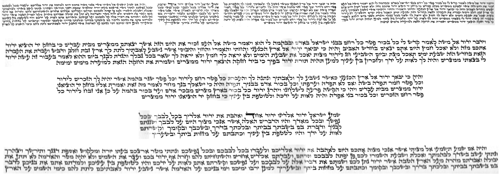
 What are Batim?
What are Batim? given for these Shin’s, especially according to Kabala. These Shin’s must be crafted out of the walls of the Batim itself. Great care is needed to produce Batim, and the Shin’s need extra special care to produce them properly.
given for these Shin’s, especially according to Kabala. These Shin’s must be crafted out of the walls of the Batim itself. Great care is needed to produce Batim, and the Shin’s need extra special care to produce them properly. 



 Therefore, there is a noticeable difference on the Batim Shel Rosh between Rashi and Rabeinu Tam. On Rashi, these hairs protrude from the left side of the Batim due to the fact that Vehoya Im Shamoa is positioned on the extreme left side of the Batim. On Rabeinu Tam it protrudes from the middle since Vehoya Im Shamoa is positioned in the second to the left Bayis.
Therefore, there is a noticeable difference on the Batim Shel Rosh between Rashi and Rabeinu Tam. On Rashi, these hairs protrude from the left side of the Batim due to the fact that Vehoya Im Shamoa is positioned on the extreme left side of the Batim. On Rabeinu Tam it protrudes from the middle since Vehoya Im Shamoa is positioned in the second to the left Bayis.